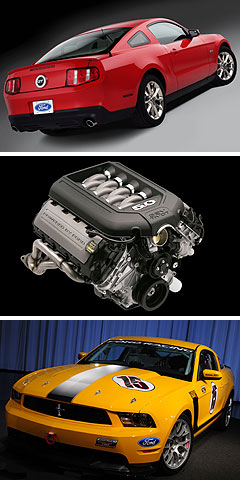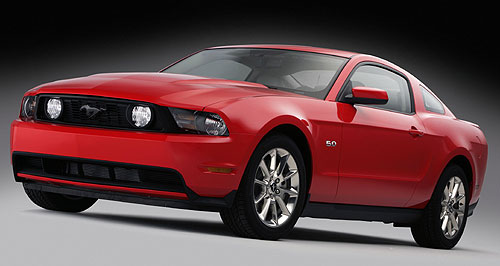Future models - Ford - FalconBlue Oval’s next V8 emerges in new Mustang GTFive-oh: New fender badges herald the return of 5.0-litre power to Ford's Mustang - and Falcon. Redesigned all-alloy 5.0-litre V8 to power new Mustang GT – and FPV’s 2010 models29 Dec 2009 FORD has unveiled the new all-alloy 5.0-litre V8 that is expected to power Ford Performance Vehicles’ 2010 model range from the middle of next year. Revealed yesterday in the US under the bonnet of Ford’s 2011 Mustang GT, the all-new V8 should replace the 5.4-litre V8 in FPV’s GT sedan and Pursuit ute models built after July 1, when strict new Euro 4 emissions laws come into effect. The Mustang GT will make its global public debut at the Detroit motor show on January 11, but performance figures for the new V8 that powers it were leaked in the US on December 18. Official Ford specifications now confirm the latest Mustang GT engine will produce 412hp (307kW) at 6500rpm and 390ft-lb (530Nm) of torque from 4250rpm. While that’s up from the 235kW/440Nm delivered by the outgoing 4.6-litre V8, the new Mustang GT’s numbers fall short of its major rivals in Chevrolet’s Australian-designed Camaro SS (426hp or 318kW) and Dodge Challenger SRT8 (425hp or 317kW). The figures are also eclipsed by the 315kW and 551Nm outputs (the latter at a higher 4750rpm) offered by FPV’s current 5.4-litre Boss V8, final assembly of which takes place at FPV’s Broadmeadows facility, but exact performance numbers for Australia’s version of the engine are not yet known. The Falcon XR8, which employs a 290kW/520Nm version of Ford's cast-iron 5.4-litre SOHC V8, is currently Ford Australia’s direct V8 answer for Holden’s popular Commodore SS, whose alloy 6.0-litre pushrod V8 delivers 270kW/530Nm. Meantime, Holden Special Vehicles’ 6.2-litre V8 continues to be the most powerful engine available in a mainstream Australian-made vehicle, with 325kW and 550Nm. It is not yet clear whether two versions of the new 5.0-litre engine will be produced for Australia – one for the 2010 XR8, one for FPV models – or whether Ford will take the unprecedented action of discontinuing the XR8, Ford’s only V8-powered Falcon, and leaving the XR6 Turbo to compete alone with the SS. FPV has confirmed a new V8 would motivate its facelifted model range from mid-2010, but company general manager Rod Barrett said in August that an even higher-performance model that reintroduces Ford’s fabled GTHO badge would not be forthcoming until the necessary hardware was available. “I would love to do it in 2011 because that would be the 40th anniversary of when Allan Moffat won Bathurst in one,” he said at the time. However, despite rumours from the US that the Ford Motor Company is also developing a twin-turbocharged version of its new ‘Coyote’ V8 – as well as larger-capacity versions displacing up to 5.8 litres - so far there is no official sign of a potential engine for a born-again GTHO from FPV.  US online publication The Detroit Bureau has reported that a twin-turbo version of the 5.0 V8 – employing a variation of the direct-injection EcoBoost technology used on the new Taurus SHO’s 3.5-litre Duratec V6 and the 2.0-litre four-cylinder engine to see duty in Ford Australia’s Falcon in 2011 – could be readied for the next Shelby GT500 Mustang, which currently packs a 400kW supercharged 5.4-litre V8. US online publication The Detroit Bureau has reported that a twin-turbo version of the 5.0 V8 – employing a variation of the direct-injection EcoBoost technology used on the new Taurus SHO’s 3.5-litre Duratec V6 and the 2.0-litre four-cylinder engine to see duty in Ford Australia’s Falcon in 2011 – could be readied for the next Shelby GT500 Mustang, which currently packs a 400kW supercharged 5.4-litre V8.Ford also produces a high-output ‘Roadrunner’ version of the naturally aspirated 5.0-litre Coyote V8, as well as an unrelated twin-turbo ‘Bobcat’ V8, which is E85 ethanol-compatible and features a compacted graphite iron (CGI) block similar to that of the 2.7 and 3.0-litre turbo-diesel V6 engine developed by PSA Peugeot-Citroen and Jaguar Land Rover. The current Mustang, which emerged at the 2008 Los Angeles motor show, is a heavily reworked version of the fifth-generation model that emerged in 2004. Based on the same platform but with a new interior and sheetmetal, it was launched in mid-2009 with 4.6-litre V8 and 4.0-litre V6 power. A replacement for the latter was revealed at last month’s LA show in the form of a 227kW 3.7-litre V6 with double overhead camshafts and 24 valves. Unlike the SOHC 4.0-litre engine, which has been built in various displacements since the 1960s, the Mustang’s first high-performance V6 will be competitive with the Camaro’s direct-injection 3.6-litre V6 – itself a close relative of the 2010 Commodore’s new V6. Like the V6, the V8 will be available with both six-speed manual and automatic transmissions in the Mustang. However, by displacing 4951cc (or just over Ford's famed 302 cubic-inch figure) via a 92.2mm bore and 92.7mm stroke, the almost-square V8 marks both the return to a genuine 5.0-litre capacity for Ford’s pony-car (which has previously employed a string of 4.9-litre engines), as well as bringing significant advances in technology, performance and efficiency. The Mustang's new aluminium-blocked V8 features quad cams, four valves per cylinder, independent variable valve timing for both intake and exhaust valves, tuned exhaust headers, a forged-steel counterweighted crankshaft and high-performance pistons and connecting rods. All this and tighter tolerances allow engine speeds of up to 7000rpm and a higher compression ratio of 11.0:1. While the new five-oh produces 31 per cent more power and 20 per cent more torque than the 4.6, which even the 3.7 V6 almost matches for peak power, Ford's latest V8 should also return five per cent better fuel economy. Ford says the 2011 Mustang GT will return highway fuel economy of 25mpg (9.4L/100km) in automatic guise – up from 23mpg (10.2L/100km) – although all other official fuel consumption figures remain unchanged from the 4.6-litre 2010 model. Ford says the engine’s Twin Independent Variable Camshaft Timing (Ti-VCT) technology is a key element in helping the new 5.0-litre V8 Mustang GT deliver class-leading performance and fuel efficiency. It has vowed to fit Ti-VCT, which was first employed on Ford’s 3.0-litre V6, in 90 per cent of its models by 2013. With an aluminium block and heads, composite intake manifold, composite cam covers and hollow camshafts, Ford claims the Boss V8 has a lower centre of gravity and a shipping weight of 195kg. While that's slightly up on the 4.6, with which the 5.0 shares its bore centres and deck height, Ford says it's 20 per cent less than its last similar-displacement engine. Also helping its fuel-efficiency is a specially tuned Electric Power Assist Steering (EPAS) system and a an extra rear decklid seal to improve aerodynamics. For 2010, the Mustang GT also gains larger ventilated brake discs, enhanced suspension componentry and new ‘5.0’ fender badges, while a Shelgy GT500 Brembo brake package and 19-inch wheels are also available. Also revealed by FoMoCo yesterday was the 5.0-litre V8-engined Mustang Boss 302R – a turn-key production-based racecar designed specifically for track days and road racing in a number of Grand-Am, SCCA and NASA classes in the US. Priced at $US79,000 ($A88,940), a total of just 50 factory Mustang racers will be produced by Ford Racing for delivery in the third quarter of 2010, each comprising the new 5.0-litre V8, six-speed manual transmission, roll cage, race seats, safety harness, data acquisition, race dampers/springs and tyres, and Brembo brakes. “This all-new 5.0-litre engine is the next chapter in the development of the world-class Mustang powertrain portfolio,” said Derrick Kuzak, Ford’s group vice-president of global product development. “It’s a thoroughly modern engine for the times, delivering the performance and fun-to-drive factor that enthusiasts want, while improving fuel economy.” While extra chassis reinforcements give the 2011 Mustang GT convertible a claimed 12 per cent increase in lateral chassis rigidity, the Mustang range will also be available in three additional paint colours for 2010 in the US - Yellow Blaze Tri-Coat, Race Red and Ingot Silver. All Mustangs will continue to be built at Flat Rock, Michigan, but while the 3.7 V6 will be produced at Cleveland, Ohio, the new V8's manufacturing site is yet to be announced.  Read more18th of September 2009  Frankfurt show: Ford’s EcoBoost future revealedFalcon’s 2011 four-cylinder engine to have at least 147kW of power and low-end mumbo11th of September 2009  Ford tests rear-drive 4cyl engine for FalconCountdown begins to Ford’s EcoBoost future as it starts 4cyl test regime25th of August 2009  FPV confirms new V8 for 2010Ford’s alloy ‘Coyote’ V8 set to ignite ‘fast Falcon’ FPV next year11th of August 2009  Ford to make call on next Falcon in 2011Current Falcon to soldier on until 2015 while Ford mulls its future24th of July 2009  Ford confirms four-pot Falcon, dumps Focus planAustralian Focus production plan abandoned as Ford announces four-cylinder Falcon15th of June 2009  Ford to decide Falcon engine futureDeadline looms for Ford’s Australian-made six-cylinder engineAll future models Alfa Romeo Alfa Romeo Abarth Abarth Audi Audi Aston Martin Aston Martin BMW BMW Bentley Bentley Chrysler Chrysler Chevrolet Chevrolet Dodge Dodge Citroen Citroen Ferrari Ferrari DS DS Ford Ford Fiat Fiat FPV FPV Foton Foton Haval Haval Great Wall Great Wall Honda Honda Holden Holden Hyundai Hyundai HSV HSV Isuzu Isuzu Infiniti Infiniti Jeep Jeep Jaguar Jaguar Lamborghini Lamborghini Kia Kia Lexus Lexus Land Rover Land Rover Mazda Mazda Maserati Maserati Mercedes-Benz Mercedes-Benz McLaren McLaren Mini Mini Nissan Nissan Mitsubishi Mitsubishi Peugeot Peugeot Opel Opel Proton Proton Porsche Porsche Renault Renault Ram Ram Saab Saab Rolls-Royce Rolls-Royce Smart Smart Skoda Skoda Subaru Subaru SsangYong SsangYong Tesla Tesla Suzuki Suzuki Toyota Toyota Volvo VolvoMotor industry news |
Click to shareFord modelsResearch Ford All future models Alfa Romeo Alfa Romeo Abarth Abarth Audi Audi Aston Martin Aston Martin BMW BMW Bentley Bentley Chrysler Chrysler Chevrolet Chevrolet Dodge Dodge Citroen Citroen Ferrari Ferrari DS DS Ford Ford Fiat Fiat FPV FPV Foton Foton Haval Haval Great Wall Great Wall Honda Honda Holden Holden Hyundai Hyundai HSV HSV Isuzu Isuzu Infiniti Infiniti Jeep Jeep Jaguar Jaguar Lamborghini Lamborghini Kia Kia Lexus Lexus Land Rover Land Rover Mazda Mazda Maserati Maserati Mercedes-Benz Mercedes-Benz McLaren McLaren Mini Mini Nissan Nissan Mitsubishi Mitsubishi Peugeot Peugeot Opel Opel Proton Proton Porsche Porsche Renault Renault Ram Ram Saab Saab Rolls-Royce Rolls-Royce Smart Smart Skoda Skoda Subaru Subaru SsangYong SsangYong Tesla Tesla Suzuki Suzuki Toyota Toyota Volvo VolvoMotor industry news |
















Facebook Twitter Instagram